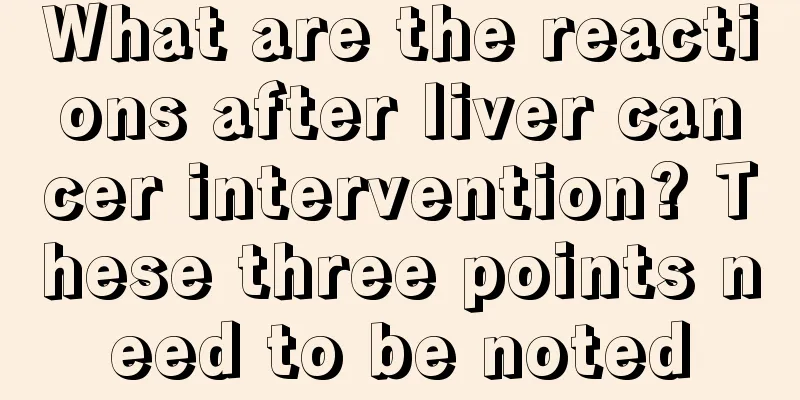What are the reactions after liver cancer intervention? These three points need to be noted

|
What are the reactions after liver cancer intervention? Primary liver cancer is one of the most common malignant tumors in clinical practice. It progresses rapidly and has hidden symptoms. A large number of patients are already in the middle and late stages when liver cancer is discovered. The main treatment method at this stage is transcatheter arterial chemoembolization (TACE), which is usually called interventional treatment. TACE embolizes the tumor's nourishing blood vessels, causing cancer cells to die due to lack of nutrition and hypoxia. It has been recommended by multiple international guidelines such as AASLD and EASL as the preferred method for treating mid-stage liver cancer, and has a good effect on mid- and late-stage liver cancer. What are the post-intervention reactions? However, TACE also has some defects that affect its efficacy, such as the high incidence of post-embolism syndrome, which manifests as pain, vomiting, abdominal distension, and fever. Fever: Fever is caused by the decomposition and absorption of the patient's necrotic cancer tissue by the human body. Generally, it will not exceed 38 degrees. Patients without infection after examination can take oral medication or use anal suppositories to relieve the patient's discomfort. Nausea and vomiting: These are digestive tract symptoms and side effects of contrast agents caused by the large use of chemotherapy drugs. They usually disappear on their own after 1 week. For patients with severe symptoms, intramuscular injection of metoclopramide or intravenous injection of ondansetron can be used. At the same time, you need to eat high-nutrition, high-protein, high-vitamin and easily digestible food, and eat small meals frequently. Drink more water after surgery and increase the amount of fluid replacement appropriately to facilitate the elimination of contrast agents and reduce the occurrence of kidney complications. Upper abdominal pain: Local ischemia of the liver after embolism can cause swelling and pain of local blood vessels in the liver, stimulation of the liver capsule, and other stimulations can cause pain. Acute arterial embolism can also cause pain in the limbs. At the same time, the effects of chemotherapy drugs can easily cause decreased immune function, bone marrow suppression, liver damage, etc. These adverse reactions after interventional surgery have a common background mechanism: inflammation caused by TACE. Modern research shows that postoperative inflammation not only causes a lot of discomfort and affects the quality of life of patients, but also has an important impact on the long-term effect of interventional treatment. Inflammatory response induced by intervention affects the efficacy Blocking the blood supply to the tissue during TACE treatment will cause degeneration and necrosis of liver cells, severe edema of interlobular tissue, and an inflammatory response. A large number of acute inflammatory cell infiltrations can be seen at the junction of the embolization area and normal liver tissue. On the one hand, this inflammatory process can cause adverse reactions such as liver damage, fever, and pain. More importantly, it can cause cell proliferation, resist apoptosis, and adjust abnormal gene expression through the inflammatory factor network, thereby promoting tumor development. At the same time, the various cytokines produced during the inflammation process can regulate the activation, migration and proliferation of endothelial cells, and call for new angiogenesis. Clinical studies have found that the severity of inflammation after TACE has an important relationship with prognosis. How to measure inflammation levels There is a close relationship between inflammation and liver cancer. The body's inflammatory state not only promotes the occurrence of liver cancer, but also has an important impact on the development of liver cancer and the prognosis of the disease. Studies have found that the higher the inflammatory indicators such as C-reactive protein, interleukin-6, and granulocyte/lymphocyte ratio (NLR) in the serum of liver cancer patients, the shorter their survival time. How does traditional Chinese medicine regulate inflammatory response after TACE surgery? Traditional Chinese medicine is widely used in the treatment of liver cancer. Many previous studies have proved the role of certain traditional Chinese medicines in killing cancer cells. However, the clinical treatment of advanced liver cancer often adopts the method of "strengthening the body". The strengthening method does not directly target cancer toxins, but it can also prolong the life of patients. This strongly suggests that the role of traditional Chinese medicine is multi-pathway and multi-target. The inflammation regulation function of traditional Chinese medicine in the treatment of other diseases such as infectious diseases may be one of the ways for traditional Chinese medicine to exert its anti-tumor effect. |
<<: Does the presence of T1 and T2 signals in the liver indicate cancer? Not necessarily
>>: What are the chemotherapy options for liver cancer? These two treatments can be used
Recommend
What happens if you wear underwear that is too tight?
It is normal for women to wear underwear, which c...
What are the factors that contribute to the cause of liver cancer?
Among cancer diseases, liver cancer is the most c...
Small airway lesions
Many people are diagnosed with "small airway...
Radical nephrectomy for nephron-sparing nephron is not a panacea
Compared with traditional radical renal cancer su...
The tongue coating is serrated
Some people find that their tongue coating has a ...
The stool starts to become dry and then becomes normal
It is normal for the stool to become dry at the b...
Is it necessary to remove the gallbladder for gallstones? Choose treatment according to the situation
The most important concern for patients with gall...
What are the effects and functions of Morganite
As we all know, most female friends have no resis...
What are the dietary taboos for lung cancer? Pay attention to the 5 dietary taboos for lung cancer
When it comes to lung cancer, many people are fam...
How to care after glioma surgery
Speaking of glioma, many people are familiar with...
How to do rectal color Doppler ultrasound
When people become ill, they should receive timel...
What's wrong with my leg pain
Many friends have experienced leg pain before, es...
Family members should strictly take care of patients with cardia cancer
Cardiac cancer is a very serious disease. Once co...
How many days is the shelf life of bread
Bread is a very common food in our lives. Nowaday...
How to treat internal carotid artery sclerosis?
How to effectively treat internal carotid artery ...









